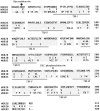Olfactory neurons expressing closely linked and homologous odorant receptor genes tend to project their axons to neighboring glomeruli on the olfactory bulb
- PMID: 10493742
- PMCID: PMC6783044
- DOI: 10.1523/JNEUROSCI.19-19-08409.1999
Olfactory neurons expressing closely linked and homologous odorant receptor genes tend to project their axons to neighboring glomeruli on the olfactory bulb
Abstract
We have characterized two separate odorant receptor (OR) gene clusters to examine how olfactory neurons expressing closely linked and homologous OR genes project their axons to the olfactory bulb. Murine OR genes, MOR28, MOR10, and MOR83, share 75-95% similarities in the amino acid sequences and are tightly linked on chromosome 14. In situ hybridization has demonstrated that the three genes are expressed in the same zone, at the most dorsolateral and ventromedial portions of the olfactory epithelium, and are rarely expressed simultaneously in individual neurons. Furthermore, we have found that olfactory neurons expressing MOR28, MOR10, or MOR83 project their axons to very close but distinct subsets of glomeruli on the medial and lateral sides of the olfactory bulb. Similar results have been obtained with another murine OR gene cluster for A16 and MOR18 on chromosome 2, sharing 91% similarity in the amino acid sequences. These results may indicate an intriguing possibility that olfactory neurons expressing homologous OR genes within a cluster tend to converge their axons to proximal but distinct subsets of glomeruli. These lines of study will shed light on the molecular basis of topographical projection of olfactory neurons to the olfactory bulb.
Figures









Similar articles
-
The OMP-lacZ transgene mimics the unusual expression pattern of OR-Z6, a new odorant receptor gene on mouse chromosome 6: implication for locus-dependent gene expression.J Neurosci. 2001 Jul 1;21(13):4637-48. doi: 10.1523/JNEUROSCI.21-13-04637.2001. J Neurosci. 2001. PMID: 11425891 Free PMC article.
-
Olfactory sensory neurons expressing class I odorant receptors converge their axons on an antero-dorsal domain of the olfactory bulb in the mouse.Eur J Neurosci. 2006 Mar;23(6):1436-44. doi: 10.1111/j.1460-9568.2006.04675.x. Eur J Neurosci. 2006. PMID: 16553607
-
Olfactory axons: a remarkable convergence.Curr Biol. 2002 Dec 23;12(24):R849-51. doi: 10.1016/s0960-9822(02)01351-9. Curr Biol. 2002. PMID: 12498705 Review.
-
The protocadherin-alpha family is involved in axonal coalescence of olfactory sensory neurons into glomeruli of the olfactory bulb in mouse.Mol Cell Neurosci. 2008 May;38(1):66-79. doi: 10.1016/j.mcn.2008.01.016. Epub 2008 Feb 13. Mol Cell Neurosci. 2008. PMID: 18353676
-
Grouping and representation of odorant receptors in domains of the olfactory bulb sensory map.Microsc Res Tech. 2002 Aug 1;58(3):168-75. doi: 10.1002/jemt.10146. Microsc Res Tech. 2002. PMID: 12203695 Review.
Cited by
-
Decoding the olfactory map through targeted transcriptomics links murine olfactory receptors to glomeruli.Nat Commun. 2022 Sep 1;13(1):5137. doi: 10.1038/s41467-022-32267-3. Nat Commun. 2022. PMID: 36050313 Free PMC article.
-
Evidence for developmentally regulated local translation of odorant receptor mRNAs in the axons of olfactory sensory neurons.J Neurosci. 2009 Aug 19;29(33):10184-90. doi: 10.1523/JNEUROSCI.2443-09.2009. J Neurosci. 2009. PMID: 19692593 Free PMC article.
-
Symmetry, stereotypy, and topography of odorant representations in mouse olfactory bulbs.J Neurosci. 2001 Mar 15;21(6):2113-22. doi: 10.1523/JNEUROSCI.21-06-02113.2001. J Neurosci. 2001. PMID: 11245695 Free PMC article.
-
Olfactory bulb mitral-tufted cell plasticity: odorant-specific tuning reflects previous odorant exposure.J Neurosci. 2003 Jul 30;23(17):6946-55. doi: 10.1523/JNEUROSCI.23-17-06946.2003. J Neurosci. 2003. PMID: 12890789 Free PMC article.
-
Intercellular interactions in the mammalian olfactory nerve.J Comp Neurol. 2003 Nov 10;466(2):230-9. doi: 10.1002/cne.10872. J Comp Neurol. 2003. PMID: 14528450 Free PMC article.
References
-
- Astic L, Saucier D. Anatomical mapping of the neuroepithelial projection to the olfactory bulb in the rat. Brain Res Bull. 1986;16:445–454. - PubMed
-
- Barth AL, Justice NJ, Ngai J. Asynchronous onset of odorant receptor expression in the developing zebrafish olfactory system. Neuron. 1996;16:23–34. - PubMed
-
- Barth AL, Dugas JC, Ngai J. Noncoordinate expression of odorant receptor genes tightly linked in the zebrafish genome. Neuron. 1997;19:359–369. - PubMed
-
- Buck LB. Information coding in the vertebrate olfactory system. Annu Rev Neurosci. 1996;19:517–544. - PubMed
-
- Buck L, Axel R. A novel multigene family may encode odorant receptors: a molecular basis for odorant recognition. Cell. 1991;65:175–187. - PubMed
Publication types
MeSH terms
Substances
Associated data
- Actions
- Actions
- Actions
- Actions
- Actions
LinkOut - more resources
Full Text Sources
Molecular Biology Databases
